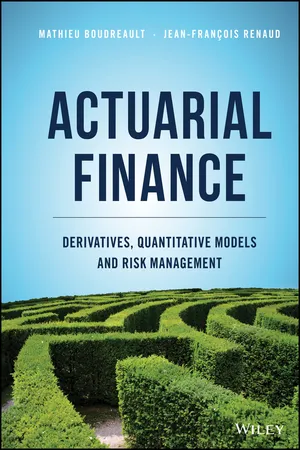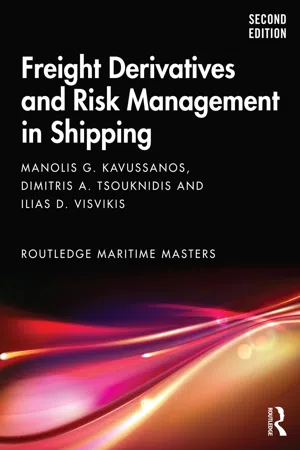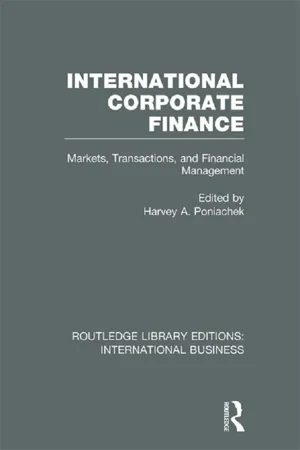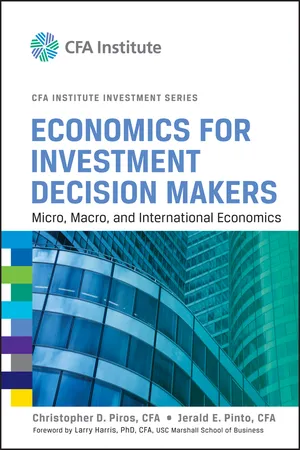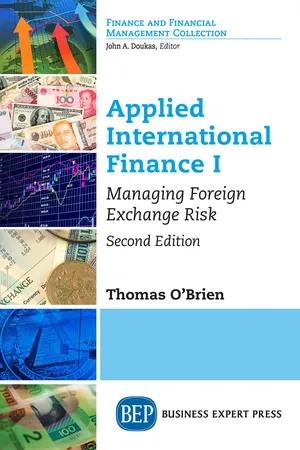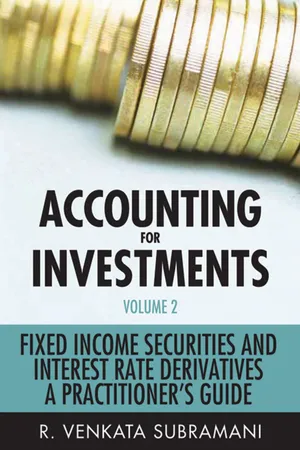Economics
FX Swaps
FX swaps, or foreign exchange swaps, are financial instruments used to exchange one currency for another on a specific date and then reverse the exchange at a later date. They allow parties to manage currency exposure and hedge against exchange rate fluctuations. FX swaps are commonly used by businesses and financial institutions to mitigate foreign exchange risk.
Written by Perlego with AI-assistance
Related key terms
Related key terms
1 of 4
Related key terms
1 of 3
7 Key excerpts on "FX Swaps"
- eBook - ePub
Actuarial Finance
Derivatives, Quantitative Models and Risk Management
- Mathieu Boudreault, Jean-François Renaud(Authors)
- 2019(Publication Date)
- Wiley(Publisher)
Interests in each currency, either fixed or floating, are exchanged on both sides. Currency swaps are used by institutional investors and multinational companies to swap foreign-denominated loans or to lower borrowing costs abroad.Example 4.3.1 Constant flow of foreign revenuesA U.S.-based insurance company also operates in Europe. Once every quarter, it will receive €1 million to be converted immediately into U.S. dollars. Let us explain how this American insurer can manage this foreign exchange rate risk over the next 12 months.The company has three options:- If the investment manager believes the USD/EUR exchange rate will move favorably in the next couple of months, then she could simply wait, receive €1 million every quarter and then convert it using the spot exchange rate. In this case, the company is fully exposed to foreign exchange rate risk.
- They could simply enter into four separate forward contracts, each to sell €1 million with maturities 3, 6, 9 and 12 months, respectively. This way, the company would fix the exchange rate for the next year.
- They could also enter into a currency swap to pay €1 million every quarter and receive in exchange a certain amount in U.S. dollars. This amount would need to be determined. Depending on the agreement, this might also require an exchange of principal at inception and at maturity.
◼An FX swap is an agreement to buy (sell) one unit of a currency in exchange for selling (buying) it back at a predetermined date in the future. The price at which it is traded in the future is the forward exchange rate (as seen in Chapter 3). Therefore, a FX swap is a long (short) spot transaction combined with a short (long) forward transaction.According to the Triennial Central Bank Survey conducted by the BIS in 2013, $2.2 trillion of FX Swaps were traded daily compared with only $54 billion of currency swaps.34.3.1 Cash flows
The cash flows of a currency swap are similar to exchanging interest payments from two loans each denominated in a different currency. This is illustrated in the next example. - Manolis G. Kavussanos, Dimitris A. Tsouknidis, Ilias D. Visvikis(Authors)
- 2021(Publication Date)
- Routledge(Publisher)
Currency swaps are derivative contracts to exchange an agreed amount of a currency for another currency at specific future dates. It constitutes an exchange of debt-service obligations, denominated in one currency, for an agreed principal amount of debt, denominated in another currency. A currency swap is often the low-cost way of obtaining a liability in a currency in which a company has difficulty borrowing from. The way this works is as follows: a pair of companies borrow in currencies they have relative advantage borrowing in, and then trade the obligations of their respective loans, thereby effectively borrowing in their desired currency. Commonly, a financial institution will match the interested companies, undertake all the paperwork and essentially eliminate the counterparty risk that exists when the companies arrange the swap between themselves.The following provides a simplified example of a currency swap. A US company would like to borrow in Swiss francs to hedge its ongoing Swiss franc-denominated cash-flows from Switzerland. A Swiss company would like to borrow in US$ to hedge its expected US$ cash receipts from its sales to the US. Both companies are relatively unknown to the credit markets of the respective foreign countries, and thus anticipate unfavorable borrowing terms. An investment bank suggests that each company borrows in the credit market it has relative comparative advantage in. Then, the investment bank will give them sufficient cash-flows in each period to cover the obligations of these loans, in return for making the payments in the foreign currency that exactly matches the other company’s obligations. The end result is that the swap contract effectively gives each company access to the foreign debt market at reasonable terms. Both companies gain, and the investment bank charges a fee for its services, typically 0.25–0.5% to each company.Currency swaps only exist because there are market imperfections. If companies can access foreign and domestic debt markets at equal cost, swaps are redundant. One important reason that currency swaps are so useful is that companies engaged in a swap need not each have an absolute borrowing advantage in the currency in which they borrow vis-à-vis the counterparty. In fact, it is possible that company B, say, has better access to both the US and Swiss debt markets than company A, and still gain through the swap transaction.- eBook - ePub
International Corporate Finance (RLE International Business)
Markets, Transactions and Financial Management
- Harvey Poniachek(Author)
- 2013(Publication Date)
- Routledge(Publisher)
Different financing options provide different benefits. Where one option might be attractive on a funding basis, another would be attractive because of the currency denomination. Seldom, however, does a single financing proposal embody the most desirable in each category. With the emergence of the swap, and more recently the interest-rate option, the borrower is now able to assemble or synthesize a financing offering the best in terms of (1) duration, (2) currency denomination, and (3) interest-rate structure.By facilitating the interchange of currency and interest-rate structures, swaps eliminate the currency and interest-rate risks that had represented a barrier between the world's capital markets. Borrowers and investors in those markets as a result have much freer access to one another, which benefits both sides: Borrowers lower their cost of capital because of a broader investor base; investors increase the diversity of their portfolios, at the same time reducing risk and enhancing the possibility of higher yields. Swaps in summary have improved the “Pareto efficiency” of the global capital market. All parties are made better off.5The Mechanics of the Currency Swap
Definition
Currency swaps can imply a number of different transaction types. In the context of this chapter the currency swap will refer to a class of currency-exchange transactions designed to hedge a currency exposure for which the conventional foreign-exchange market is inadequate due to the length of the tenor and the size and structure of the transaction. The transaction may or may not involve a bank dealer but does not rely exclusively on the interbank foreign-exchange market for its pricing. Swap pricing is generally determined using one or more of the following market indicators, either explicitly or by reference: Domestic or international bond yields, money-market rates, interest-rate and cross-currency interest-rate swap yields, forward foreign-exchange points, financial futures prices, and so forth. - eBook - ePub
Economics for Investment Decision Makers
Micro, Macro, and International Economics
- Christopher D. Piros, Jerald E. Pinto(Authors)
- 2013(Publication Date)
- Wiley(Publisher)
An FX swap is best illustrated by an example. Suppose that a trader sells 100 million euros with settlement 95 days from today at a forward exchange rate (USD/EUR) of 1.2500. In 93 days, the forward contract is two days from settlement, specifically the T + 2 days to spot settlement. To roll the forward contract, the trader will engage in the following FX swap. First, the trader will need to buy 100 million euros spot, for which T + 2 settlement will fall on day 95, the same day as the settlement of the expiring forward contract. The purchase of the 100 million euros spot will be used to satisfy the delivery of the 100 million euros sold in the expiring forward contract. Because 100 million euros are being both bought and sold on day 95, there is no exchange of euros between counterparties on that day: The amounts net to zero. However, there will be an exchange of U.S. dollars, reflecting the movement in exchange rates between the date the forward contract was agreed to (day 0) and day 93. Suppose that on day 93 the spot exchange rate for USD/EUR is 1.2400. This means that the trader will see a cash flow on day 95 of USD1,000,000. This is calculated as follows:EUR100,000,000 × (1.2500 − 1.2400) = USD1,000,000The trader receives USD1,000,000 from the counterparty because the euro was sold forward to day 95 at a price of 1.2500; it was bought (on day 93) for spot settlement on day 95 at a price of 1.2400. This price movement in the euro indicates a profit to the trader, but because the euro quantities exchanged on day 95 net to zero (100,000,000 euros both bought and sold), this cash flow is realized in U.S. dollars. The second leg of the FX swap is then to initiate a new forward sale of 100 million euros at the USD/EUR forward exchange rate being quoted on day 93. This renews the forward position (a forward sale of the euro) to a new date.For the purposes of this chapter, it is only necessary to understand that (1) an FX swap consists of a simultaneous spot and forward transaction; (2) these swap transactions can extend (roll) an existing forward position to a new future date; and (3) rolling the position forward leads to a cash flow on settlement day. This cash flow can be thought of as a mark-to-market on the forward position. FX Swaps are a large component of daily FX market turnover because market participants have to roll over existing speculative or hedging positions as the underlying forward contracts mature in order to extend the hedge or speculative position (otherwise, the position is closed out on the forward settlement date).One other area where FX Swaps are used in FX markets also bears mentioning: They are often used by market participants as a funding source (called swap funding). Consider the case of a UK-based firm that needs to borrow GBP100 million for 90 days, starting two days from today. One way to do this is simply to borrow 90-day money in GBP-denominated funds starting at T + 2. An alternative is to borrow in U.S. dollars and exchange these for British pounds in the spot FX market (both with T + 2 settlement) and then sell British pounds 90 days forward against the U.S. dollar. (Recall that the maturity of a forward rate contract is defined in terms of the spot settlement date, so the 90-day forward rate would be for settlement in 92 days from today.) The company has the use of GBP100 million for 90 days, starting on T + 2, and at the end of this period can pay off the U.S. dollar loan at a known, predetermined exchange rate (the 90-day forward rate). By engaging in simultaneous spot and forward transactions (i.e., an FX swap), the company has eliminated any FX risk from the foreign borrowing. The all-in financing rate using an FX swap will typically be close to that of domestic borrowing, usually within a few basis points. This near equivalence is enforced by an arbitrage relationship that will be described in Section 3.3. On large borrowing amounts, however, even a small differential can add up to substantial cost savings. - eBook - ePub
- Thomas J. O'Brien(Author)
- 2017(Publication Date)
- Business Expert Press(Publisher)
CHAPTER 6Currency Swaps“The advent of swaps, as much as anything else, helped transform the world’s segmented capital markets into a single, truly integrated, international capital market.”—John F. Marshall and Kenneth R. Kapner (1993)A currency swap is a contract to exchange two streams of future cash flows in different currencies. Currency swaps were initially designed to circumvent capital controls imposed by governments and to make borrowing more efficient in global markets. We will see that currency swaps are used to convert debt denominated in one currency into “synthetic” debt denominated in another currency. Synthetic debt created in this way sometimes allows a segment of the capital market to be tapped that would otherwise not be accessible with actual debt denominated in that currency. By themselves, moreover, currency swaps are useful in managing FX business exposure in situations where foreign currency net debt is not practical.World Bank—IBM SwapThe first currency swap seems to be a 1981 transaction between the World Bank and IBM. Its details are instructive. The World Bank wanted to raise additional capital by issuing new debt and to denominate the debt payments in Swiss francs because of a low market interest rate in that currency. The U.S. bond market, though, was more receptive to World Bank bonds than was the Swiss bond market, because the World Bank had already saturated the Swiss market’s “appetite” for its bonds, and U.S. investors regarded World Bank bonds to have much less credit risk than Swiss investors did. However, the U.S. investors wanted bonds denominated in US dollars.At the same time, IBM had previously financed by issuing some Swiss franc debt, but had since developed the view that the Swiss franc was undervalued, and thus was likely to appreciate abnormally relative to the US dollar. IBM thus wanted to replace its Swiss franc debt with US dollar debt. But issuing new US dollar bonds and using the proceeds to repurchase the Swiss franc bonds would be relatively expensive in terms of transaction costs. - eBook - ePub
Accounting for Investments, Volume 2
A Practitioner's Handbook
- R. Venkata Subramani(Author)
- 2011(Publication Date)
- Wiley(Publisher)
F-47On settlement of interest on pay leg: (T-16 @ FX Rate: 1.5020)F-48 On accounting for FX Translation on settlement of interest on pay leg of XCCY Swap:F-49 On accounting for FX Translation on Bank account:SUMMARY- Currency swaps are over-the-counter derivatives, and are similar to interest rate swaps covered already in this volume except that in a cross-currency swap the principal amounts are in different currencies and unlike interest rate swaps, cross-currency swaps can involve the exchange of the principal.
- Even where there is no exchange of principal, the counterparties are subject to the foreign exchange rate fluctuation during the substance of the trade.
- The tenure of a cross-currency swap typically ranges from one to fifteen years.
- Cross-currency swaps are suitable for entities that have a loan commitment denominated in one currency, while the revenues generated by the entity are denominated in a different currency, resulting in a currency mismatch between the currency of the loan and the currency of revenues.
- A Cross-currency interest rate swaps allow an entity to switch its loan from one currency to another.
- A Cross-currency interest rate swaps enable an entity to manage foreign currency exposures. The entity can use money it receives in one currency to pay off its loans in another currency with a cross-currency swap.
- Since a cross-currency swap is basically an interest rate swap, all the risks associated with an interest rate swap in terms of interest rates do exist in this instrument.
- The single important reason for entering into a cross-currency swap is to manage foreign exchange exposure. This also becomes a huge risk if not managed properly.
- eBook - ePub
FX Trading
A Guide to Trading Foreign Exchange
- Alex Douglas, Larry Lovrencic, Peter Pontikis(Authors)
- 2011(Publication Date)
- Wiley(Publisher)
Chapter 2: What is foreign exchange?The abbreviations and words ‘FX’, ‘forex’ and ‘foreign exchange’ are all interchangeable terms used to describe the market in which the currency of one country is exchanged for that of another country. Foreign exchange transactions may be as simple as those encountered by a tourist when visiting a local money changer to conduct a physical exchange of one currency for another, or as complex as multi-legged option strategies executed between global investment banks over electronic trading platforms with multiple settlement dates in multiple currencies. Each transaction forms a part of the foreign exchange market.An important concept to understand from the beginning is that, unlike the equities and futures markets, the foreign exchange market does not have a physical ‘exchange’ in which transactions are conducted. Nor is there a single electronic platform for the execution of FX trades. Foreign exchange is what is known as an ‘over-the-counter’ (OTC) market. In basic terms, this means that any two parties that come together and exchange currencies between one another on agreed terms are participating in the foreign exchange market. Unlike an ‘exchange-traded market’, like that which operates through the Australian Securities Exchange (ASX), with an OTC market there is no need for either party to report a trade to a central exchange, or for any other third party to ever know of the existence of the trade.While it is possible for every foreign exchange transaction to have a unique set of characteristics agreed to by each party, for the sake of simplicity and efficiency certain market conventions have emerged that allow for trading to take place within a framework of standard rules and conditions. These FX market conventions cover issues such as quoting methodology, terminology, and settlement dates and procedures. Because foreign exchange trading follows these conventions, we can view trades executed via many different methods as all forming a part of the one market. Don’t worry, we’ll get to explanations of the different methods of FX trading over the next few chapters.
Index pages curate the most relevant extracts from our library of academic textbooks. They’ve been created using an in-house natural language model (NLM), each adding context and meaning to key research topics.
Explore more topic indexes
Explore more topic indexes
1 of 6
Explore more topic indexes
1 of 4
